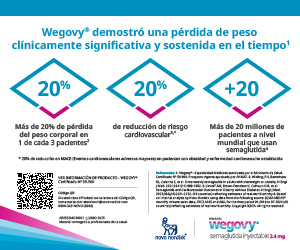P12 Factores de riesgo para diabetes mellitus tipo 2. ¿En qué grupo etario buscarlos?
DOI:
https://doi.org/10.47196/diab.v54i3Sup.393Palabras clave:
factores de riesgo, mellitus tipo 2, búsquedaResumen
Introducción: la diabetes tipo 2 (DM2) es una patología que se desarrolla progresivamente ante la presencia de factores de riesgo (FR) predisponentes y que deberían identificarse previo a su diagnóstico.
Objetivos: detectar e identificar los FR para DM2 en población adulta de la provincia de Neuquén a fin de realizar prevención primaria para DM2.
Materiales y métodos: estudio descriptivo de 1.232 encuestas anónimas realizadas en la provincia de Neuquén entre 2017 y 2018, dirigidas a adultos ≥20 años sin diagnóstico conocido de DM2, en 10 ciudades del territorio neuquino. Las mismas fueron contestadas por autorreporte (AR) o por encuestador (ENC) adiestrado a tal efecto y que realizaron medidas antropométricas. Se dispusieron encuestas con urnas en reparticiones municipales, provinciales, privadas, escuelas, farmacias y salas de espera de centros asistenciales. La misma se basó en la encuesta FINDRISC original que estima el riesgo de desarrollar DM2 en los siguientes 10 años. También se incluyeron 4 (cuatro) preguntas adicionales, sin puntaje. Todas las encuestas fueron remitidas a un mismo lugar para su análisis estadístico. Variables originales FINDRISC: Sexo: femenino (F) y masculino (M). Grupo etario (GE): <45, 45-54, 55-64, >65 años, puntaje (P) 0-2-3-4. Índice de masa corporal (IMC): <25, 25-30, >30 P 0-1-4. Circunferencia de cintura (CC) P: 0-3-4 sexo F: <80, 80-88, >88 cm, sexo M: <94, 94-102, >102 cm. Actividad física (AF) 30 minutos/día SÍ/NO, P 0-2. Consumo de vegetales/frutas (VyF) SÍ/NO con P 0-2. Antecedente de Azúcar elevada en Sangre (AGluc) NO/SÍ P 0-5. Antecedente Familiar con DM 1 ó 2 (AFDM): NO, familiar en 2° ó en 1°, con P 0-3-5. HTA: NO/SI. Categorías de riesgo del FINDRISC (R): Bajo (RB) <7 P, ligeramente elevado (RLE) 7-11 P, moderado (RM) 12-14 P, alto (RA) 15-20 P, muy alto (RMA) >20 P. Variables agregadas, sin puntaje: tabaquismo (Tab), colesterol elevado (Col), hijo nacido de ≥4 Kg de peso (RNAP) y familiar con ACV/IAM (FECV), respuestas: NO/SÍ. La encuesta incluye un troquel que la persona debía conservar y donde se lo invita a hacer consulta médica en caso de tener P ≥15. La encuesta en sí debía ser depositada en la urna.
Resultados: variables de la muestra total (N) 1.232 personas: Llenado por AR 453 (36,8%) por ENC 779 (63,2%); Sexo F 822 (66,7%) M 410 (33,3%); GE en >45: 706 (57,3%), de 45-54: 266 (21,6%), de 55-64: 174 (14,1%), en >65: 86 (7,0%); IMC (n 1230) <25: 394 (32,0%), 25-30: 450 (36,6%), >30: 386 (31,4%); CC F (n 823) <80: 249 (30,3%), 80-88: 199 (24,2%), >88: 374 (45,5%); CC M (n 395) <94: 144 (36,5%), 94-102: 139 (35,2%), >102: 112 (28,4%); AF (n 1224) SI: 608 (49,7%), NO: 616 (50,3%); VyF SI: 747 (60,6%), NO: 485 (39,4%); AGluc (n 1208) NO: 981 (81,2%), SI: 227 (18,8%). AFDM NO: 600 (49,2%), en 2° 268 (21,9%), en 1° 352 (28,9%). HTA (n 1216) NO: 1004 (82, 6%), SI: 212 (17,2%). Variables agregadas: Tab (n 1110) NO: 782 (70,5%), SI:119 328 (29,5%); Col (n 1128) NO: 861 (76,3%); RNAP (n 1031) NO: 694 (85,4%), SI: 119 (14,6%); FECV (n 1031) NO: 671 (65,1%), SI: 360 (34,9%). Los datos observados se los clasifica según grupo etario y se realiza el análisis estadístico de las variables con prueba de Chi cuadrado. Se observó diferencia estadísticamente significativa respecto del sobrepeso más obesidad en hombres del grupo etario <45 años y en el grupo entre 45-54 años siendo 0,001 y 0,01, respectivamente. En los demás grupos, no se encontró diferencia. No hubo relación significativa respecto de la actividad física en ningún grupo. Asimismo, se ve aumento progresivo de los FR a mayor grupo etario. El porcentaje de sobrepeso más obesidad, como también la CC, es elevado en todos los grupos, correspondiendo en el total a 25,6% para sobrepeso y 69,2% para obesidad. Existe bajo consumo de frutas y verduras, sin diferencias entre grupos. Las variables agregadas no aportaron datos relevantes. Variables de la muestra total, según GE.
Conclusiones: es necesario insistir en la búsqueda de los FR y desarrollar estrategias y programas preventivos a largo plazo y toda edad. En particular controlando la obesidad, a fin de retardar o evitar el desarrollo de diabetes tipo 2.
Descargas
Publicado
Número
Sección
Licencia

Esta obra está bajo una licencia internacional Creative Commons Atribución-NoComercial-SinDerivadas 4.0.
Dirección Nacional de Derecho de Autor, Exp. N° 5.333.129. Instituto Nacional de la Propiedad Industrial, Marca «Revista de la Sociedad Argentina de Diabetes - Asociación Civil» N° de concesión 2.605.405 y N° de disposición 1.404/13.
La Revista de la SAD está licenciada bajo Licencia Creative Commons Atribución – No Comercial – Sin Obra Derivada 4.0 Internacional.
Por otra parte, la Revista SAD permite que los autores mantengan los derechos de autor sin restricciones.




























